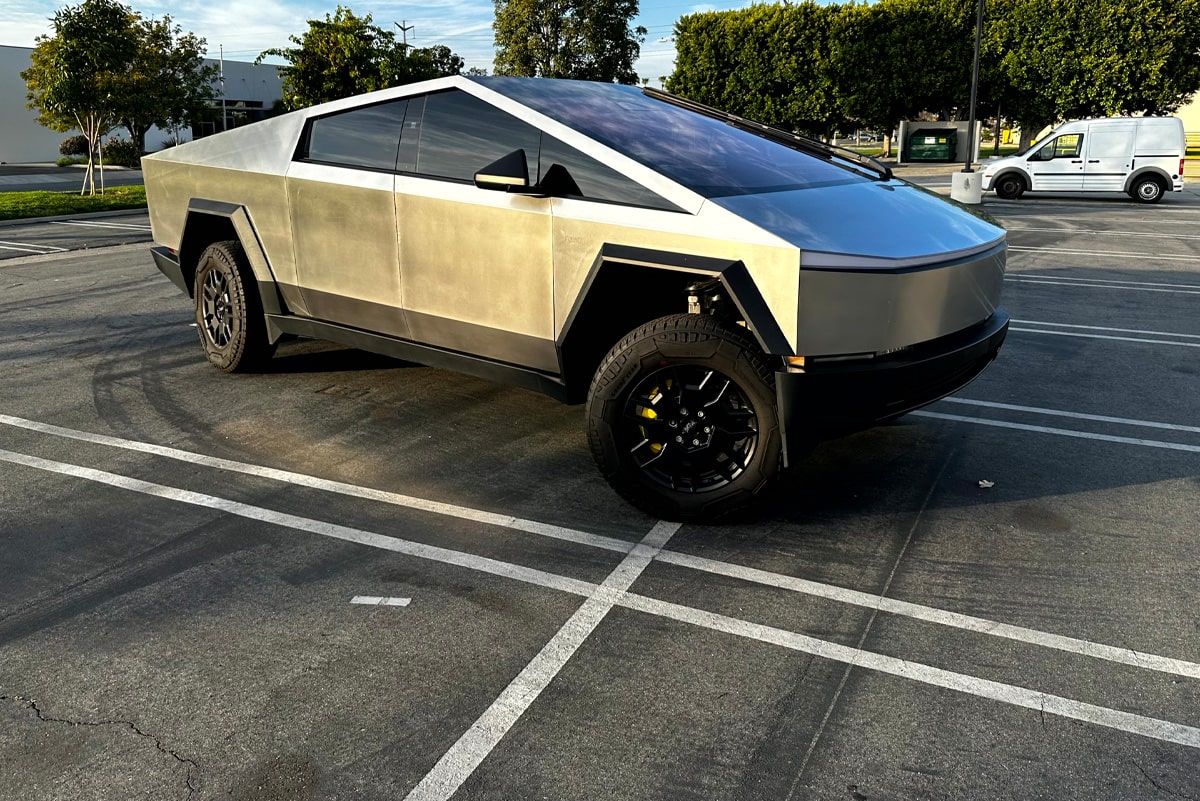
Tesla Cybertruck Review: Stand out from the crowd and a new steering feel
Traffic in Los Angeles is a given, as are traffic jams during rush hour. Car after car, on five lanes in each direction, sometimes rolling faster but mostly slower. Pickups, SUVs, sedans. Black, white, blue, silver. GMC, Ford, Toyota, Honda, BMW. This was the usual picture, but this time, something changed. There are all kinds of Teslas to be seen, and even the rivalling Rivians have become a more frequent sight, both as pickups and with fixed roofs.
But even in this mass of beautiful new and rusty old vehicles, one massive car stands out in the setting evening sun. Tesla’s Cybertruck immediately catches our eye from inside the taxi. The car is wide, framed by a continuous strip of lights, angular in shape, interrupted by the large black windscreen. We let the behemoth overtake us, and it is quite unlike anything else on the road here: the Tesla Cybertruck looks like a spaceship in the middle of the traffic.
Around 15 hours later, we took delivery of our Cybertruck and spent two days testing it on the roads around LA: driving, charging, assistance systems, connectivity – and most importantly – standing out.
Small stumbling blocks at the start
We hired the Tesla through an agency. The owner texts us in a friendly and courteous manner to give us instructions and send a video on how to operate the Cybertruck. “While I’m sure you are familiar with driving a Tesla, here are a few important points to keep in mind when driving the Cybertruck so that you can fully experience the incredible technology it offers.” We’d find out later what he meant. He also warns us that we will attract attention. “Please enjoy it, but also bring dark sunglasses because everyone’s going to stare and take pictures and videos of you.”
The morning before the handover, we received another link via iMessage: “I’m sharing my Tesla with you. Tap the link to accept”. We have already installed the US version of the Tesla app but are logged in with a German Tesla account. That doesn’t work. So, we created a US Tesla account and tried again. We get the notification “Success. Vehicle added”. Our Cybertruck shows as “Rusty” – as the owner has named him – and the app includes a vehicle image, range, location, and phone key as usual.
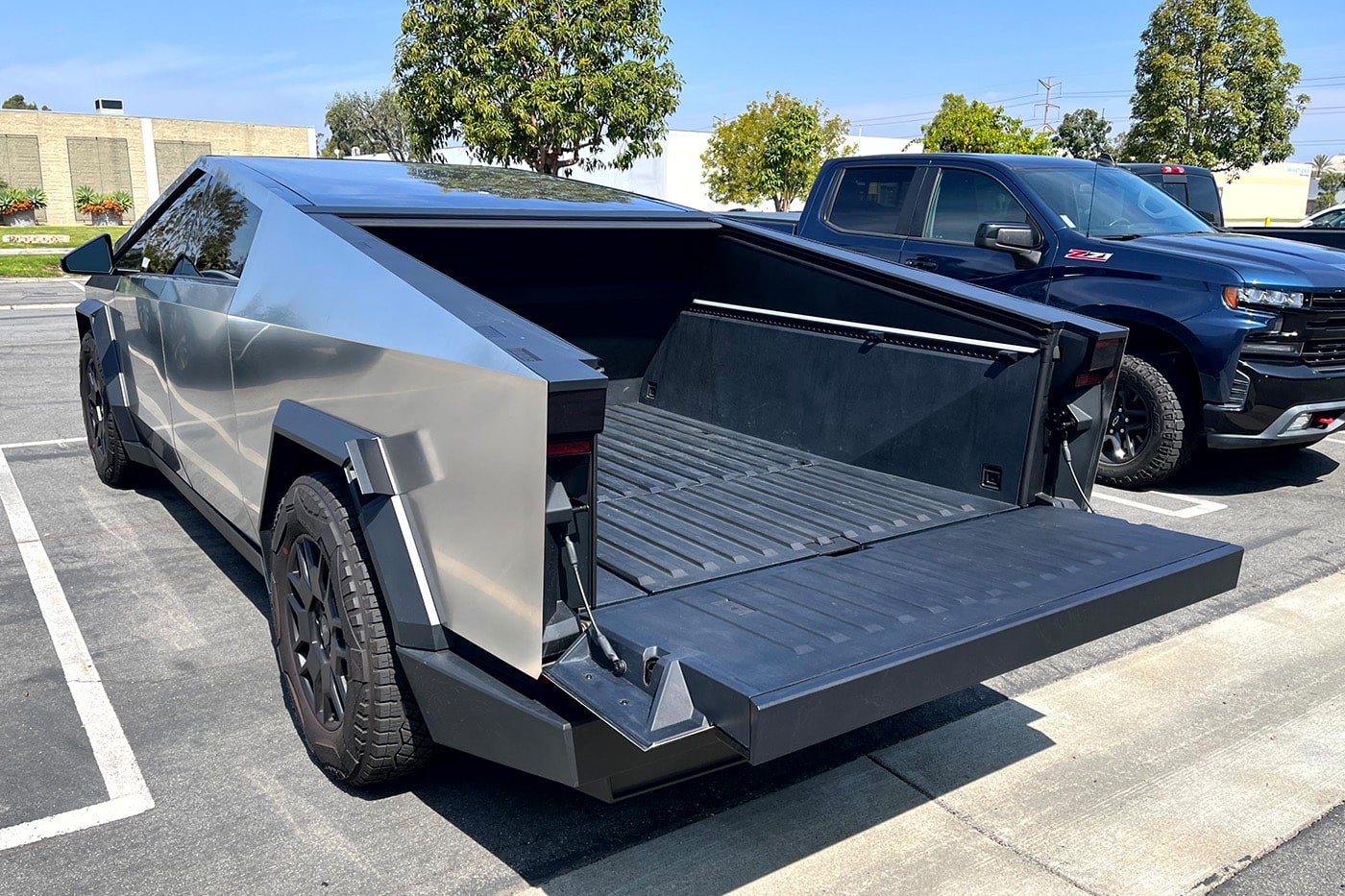
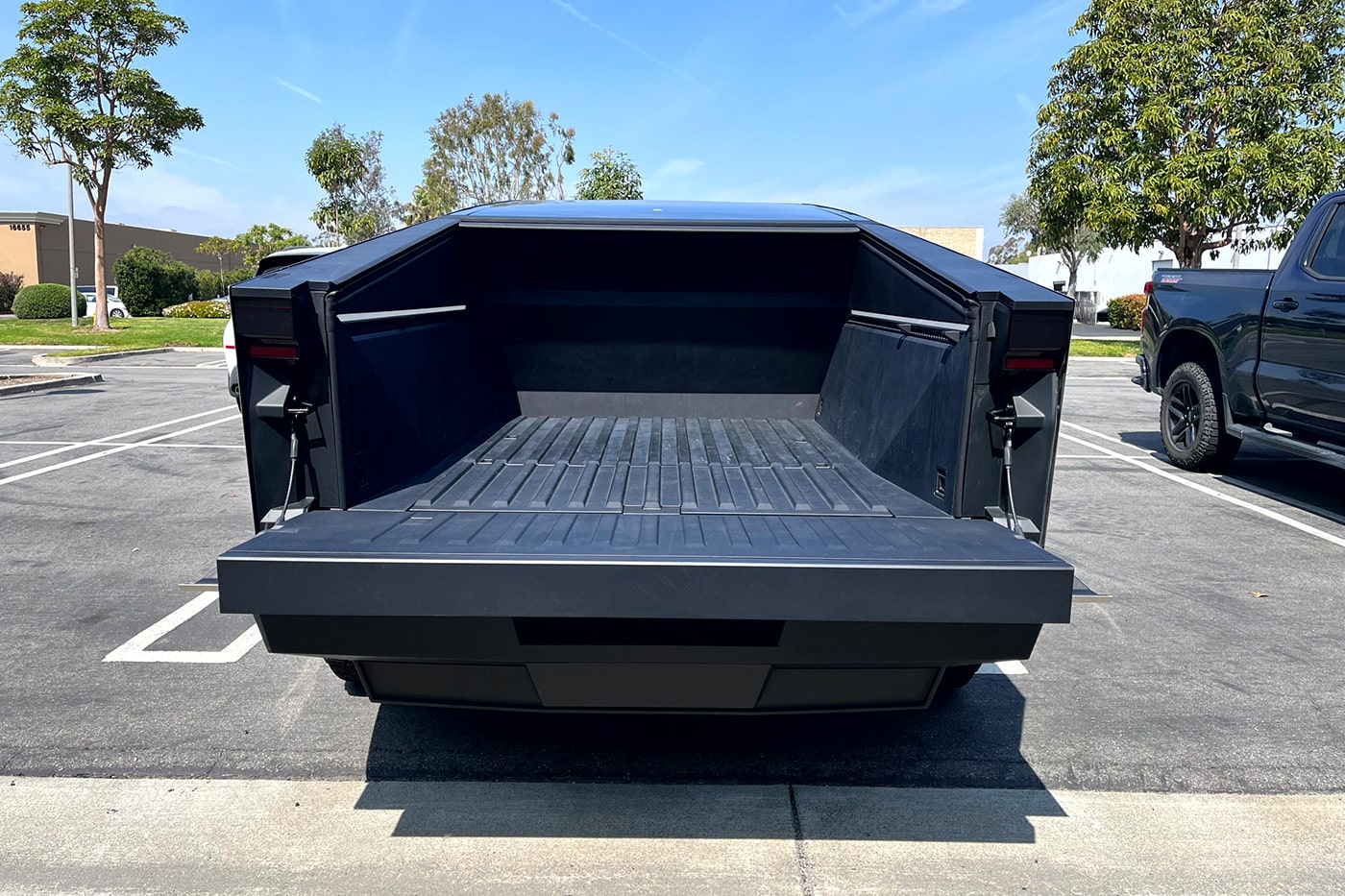
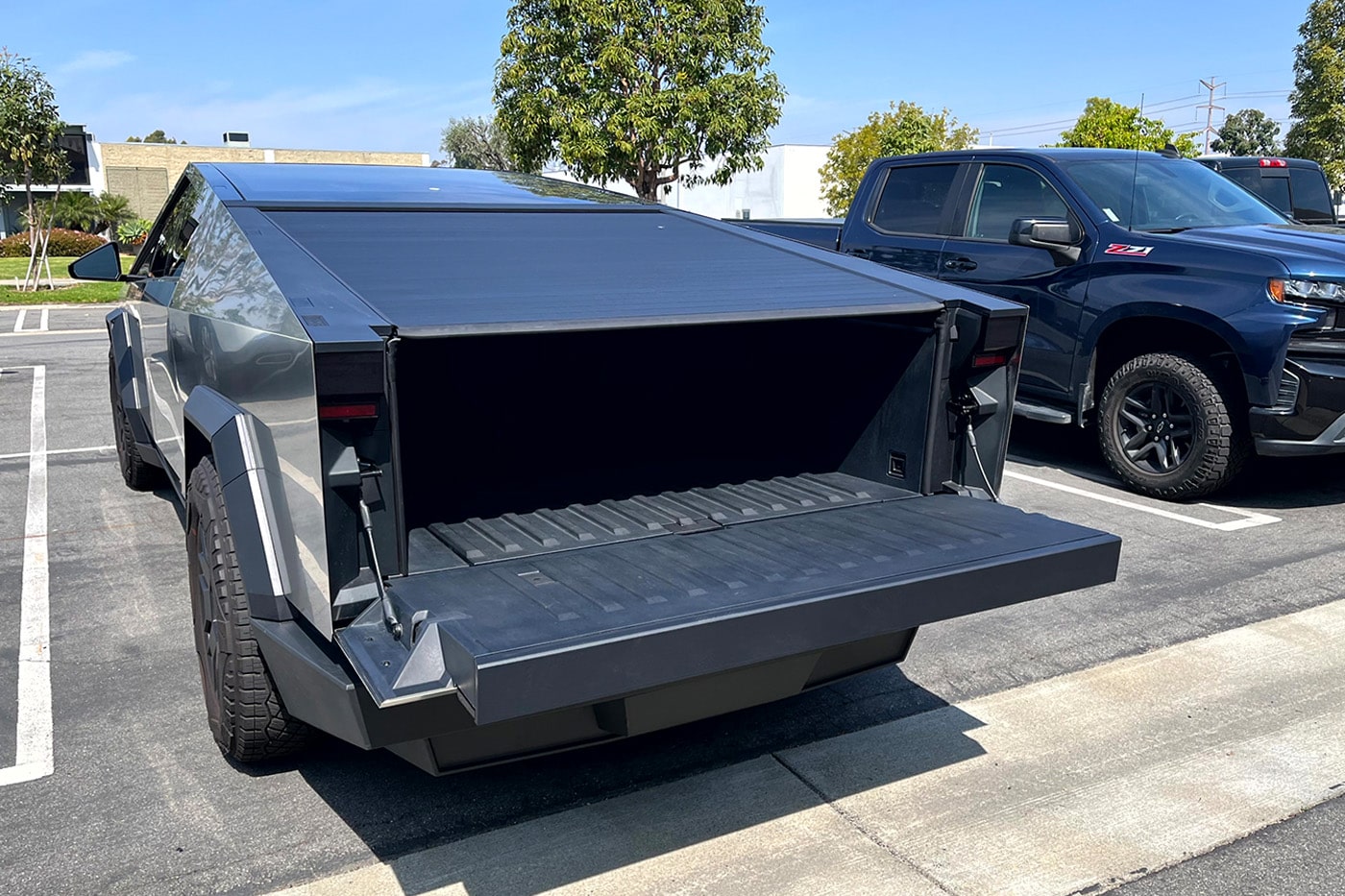
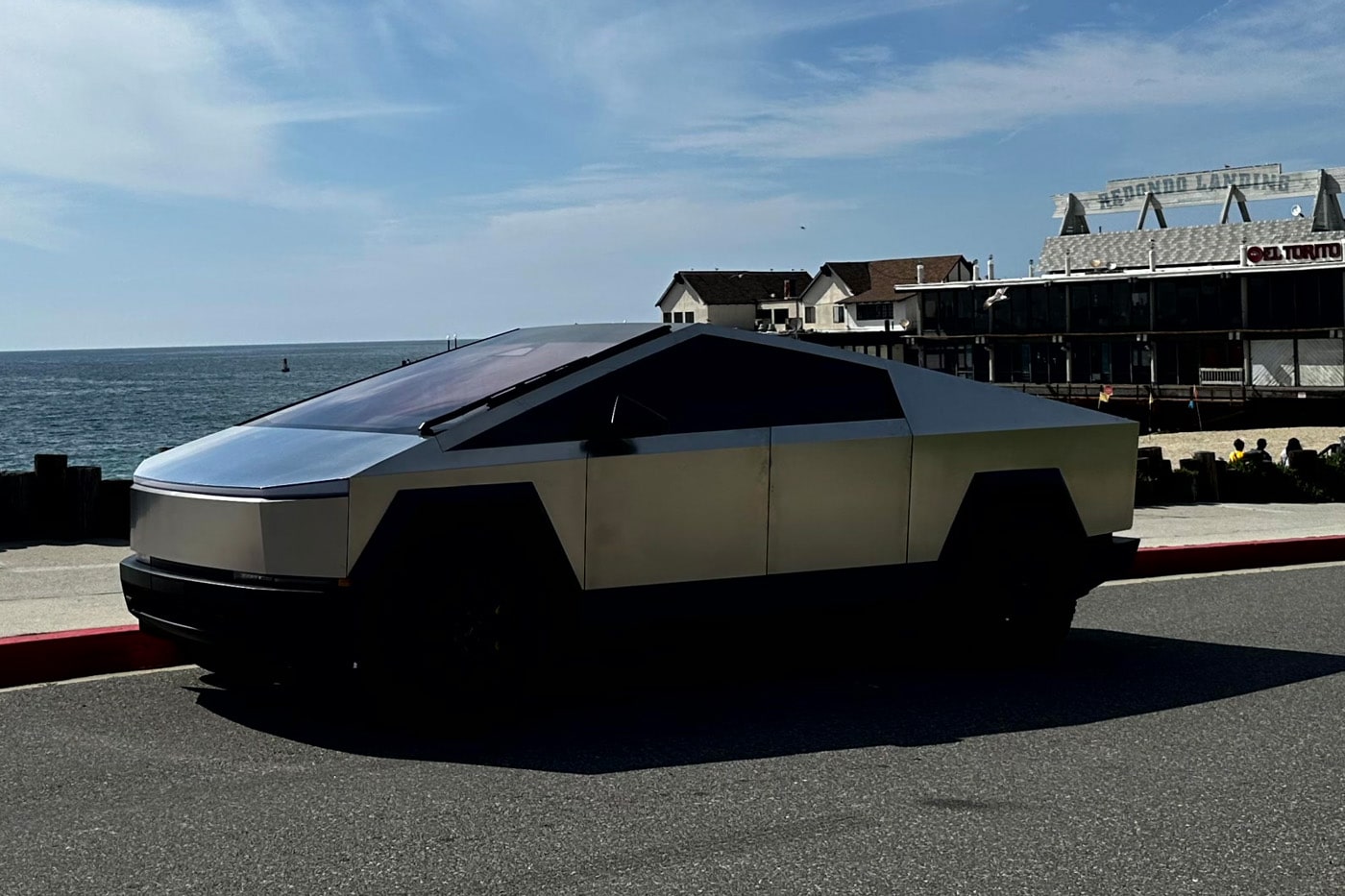
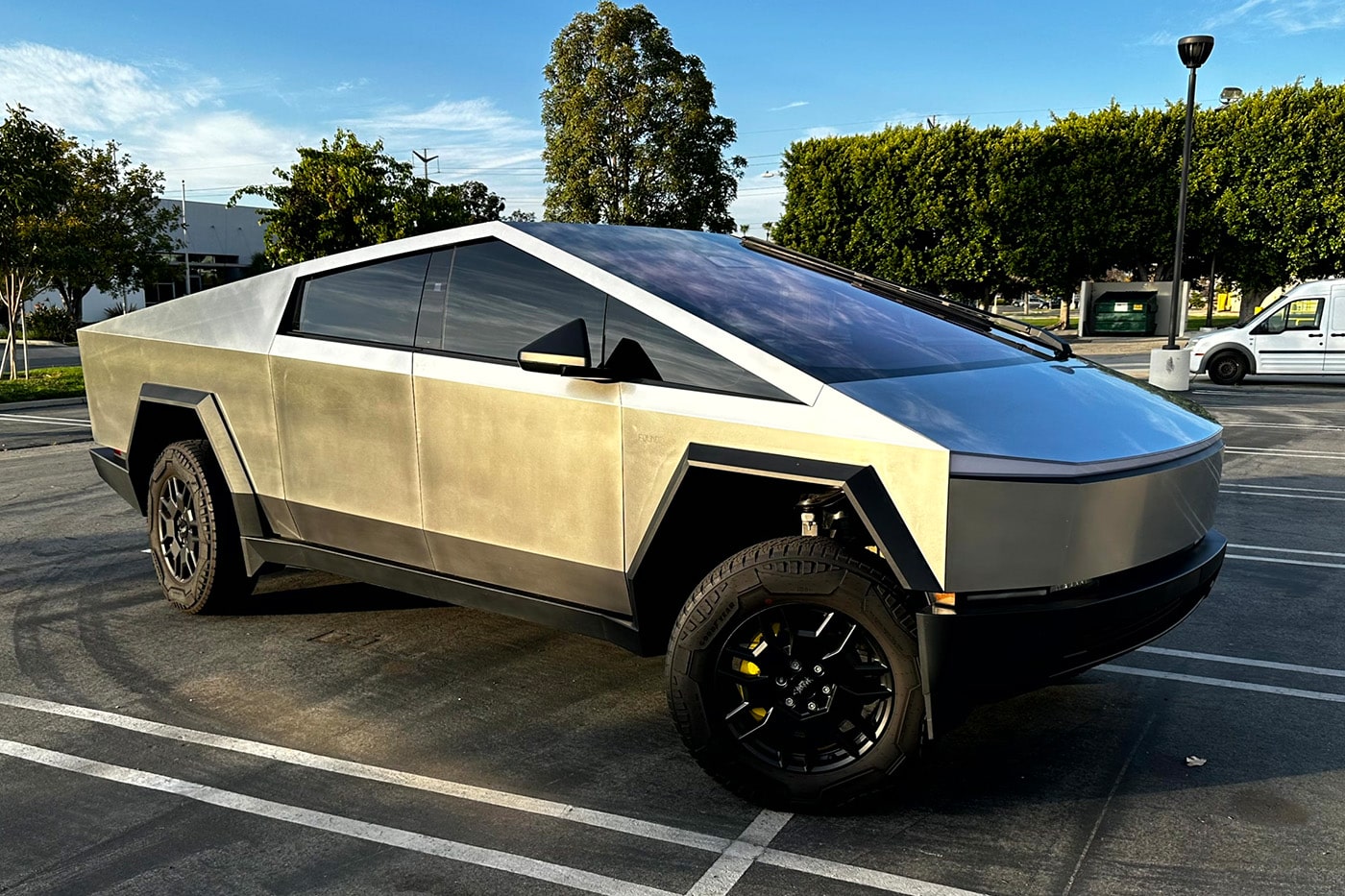
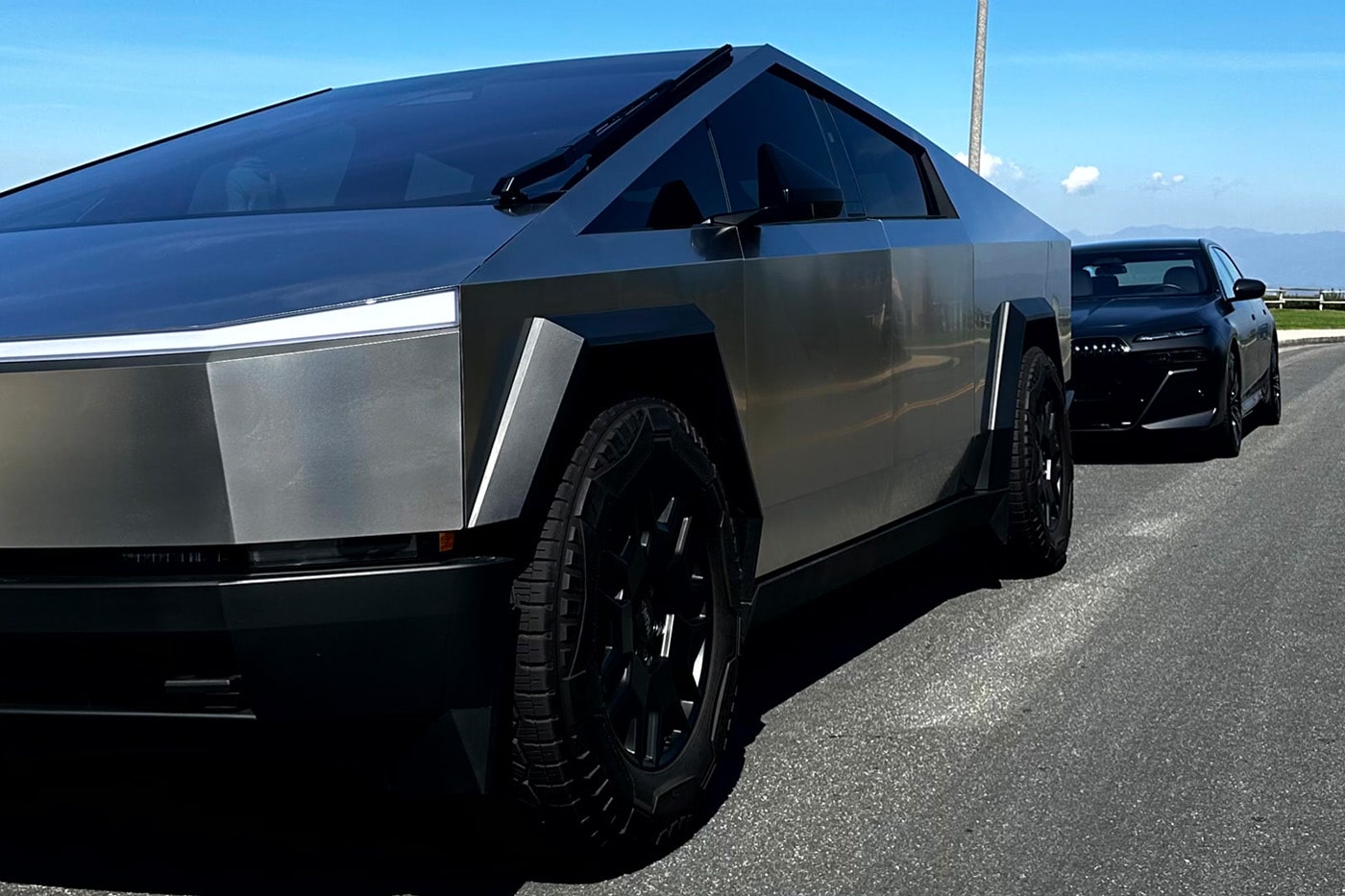
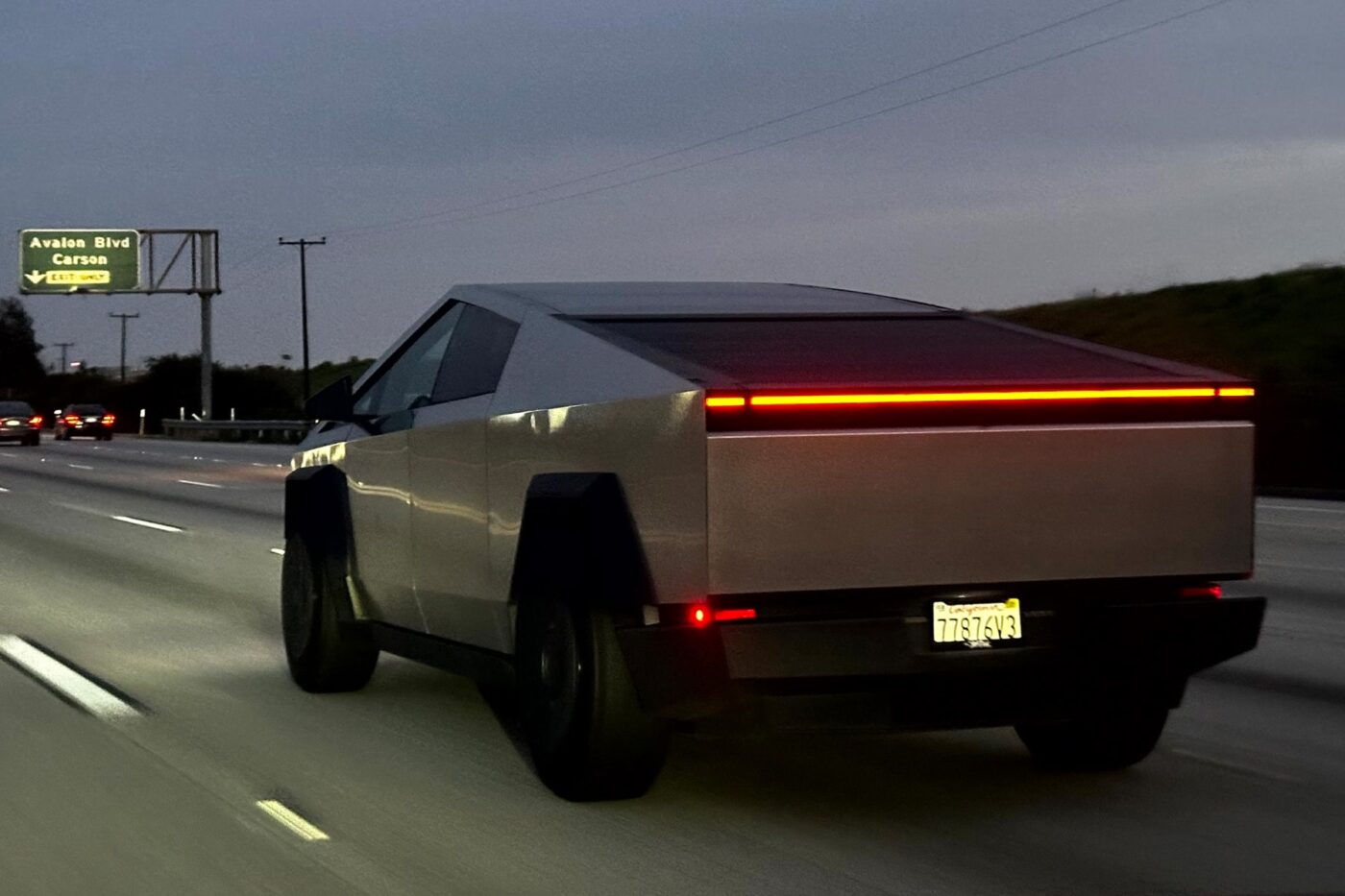
We are off to pick up the car. The app shows the vehicle’s location, and our BMW i7 xDrive60 makes its way through the south of the Californian metropolis, then turns off the boulevard into a residential street. There it is, under trees in a car park in front of an iPhone repair shop. The scene looks surreal – an alien shape in our familiar world. This vehicle is unlike anything we have ever seen or driven before.
Surprisingly, it seems smaller than expected, although this does not mean that it is actually small, quite the opposite. The slightly tarnished, stained surface seems true to its given name, Rusty, although Tesla advertises the opposite with its “stainless steel”, supposedly three millimetres thick and manufactured using space technology. The windows are tinted black, and matching black components contrast the steel and make for an appealing design.
The four doors are just as angular as the rest of the body. There is nothing as traditional as handles. The vehicle stands on black 20-inch rims; the corresponding Goodyear studded tyres have the relatively modest size of LT285/65R20/123/120H (the original spare tyre, including tools, can be purchased for 1,250 US dollars). Behind the tyres is a striking yellow brake. Plaques with engraved ‘Cybertruck’ lettering are emblazoned on the wheel hubs. A rear windscreen? Not to be seen. All we can see is the black tonneau cover of the pickup truck bed. However, a sizeable reversing camera in the centre of the light strip at the rear catches the eye, obviously an essential feature. There is a large, recessed button in the B-pillar. If you press this, the door opens a crack. However, a full electric opening, as offered by the BMW i7, is not possible here.
The interior is similar to what we are used to from Tesla, somewhat reminiscent of the Model S Plaid; only everything is one size bigger. Instead of the yoke steering wheel from the Model S, the Cybertruck has an octagonal, narrow steering wheel, which fronts a white leather-covered “instrument panel”. To the right is an 18.5-inch central display with the familiar Tesla user interface from the Model 3 Highland and Model S Plaid.
The front seats are made from black leather, and a three-person bench is in the back. Rear-seat passengers have a 9.4-inch display in the centre console, which can be used to operate the climate control, Netflix and audio. All in all, the overall appearance corresponds to the current Tesla standard, as familiar from the Model S and Model X.
Enough looking, let’s get going
The driving mode can be selected either via the central display (push the car forwards) – similar to the Model 3 Highland or Tesla Model S Plaid – or in a much more casual way: capacitive ‘P N R D’ buttons are embedded in the roof, where they “replace” the interior mirror. Put your foot on the brake, press ‘D’, and off you drive at the tip of a finger.
At the first turn of the steering wheel, it becomes clear what is new here: this Tesla comes with steer-by-wire and counter-rotating rear-axle steering. Steer-by-wire means that there is no longer a mechanical linkage between the steering wheel and the front axle. The steering is, therefore, purely electronic. The first few metres are unfamiliar. Minimal “steering travel” – significant steering effect. It takes us a few minutes to get used to it.
Steer-By-Wire also presents a few parking difficulties because the vehicle cannot be steered as accurately as we are used to with standard steering systems, especially at full steering lock. This is because the higher the steering angle, the less precise the steering travel. The first real-life attempts to park in a restaurant’s parking lot prove difficult, and the employee, who is taking a break, films the action. But once we have mastered the first few tests, we start finding it exciting. No more “cranking” the steering wheel and we quickly got used to it.
And we would need to get used to another thing. We are often filmed and photographed over the next few days. At traffic lights, in traffic jams, on the motorway, when parking. Always, in fact. Many people smile at us, give us the thumbs up, and talk to us. People in California love the car. “Is that a Tesla?” “Yes, that’s Tesla’s Cybertruck” “Oh really? It’s such a cool car. Can I take a photo?”
High consumption, large battery
Regarding consumption, we achieved a value of 39.9 kWh per 100 miles, corresponding to 24.9 kWh/100 kilometres. It has to be said that we mostly drove on highways at the permitted 65 miles per hour, i.e. at around 100 kph. The results would definitely be different in Europe. In the Edmunds.com range test, a real-world range of 334 miles (537 km) was achieved with a consumption of 45.1 kWh per 100 miles. The US EPA certifies the Cybertruck with a range of 318 miles (512 km) with its 123-kWh battery, which we exceeded in our real-world road test.
Compared to other vehicles, these are exciting figures: the Model 3 Highland achieved a maximum of 338 miles or 544 kilometres at Edmunds.com. In comparison, the Model S Plaid managed 345 miles (555 km), but both have significantly smaller batteries and significantly lower consumption simply due to their size and weight. The situation is similar for the Cybertruck’s competitors: The GMC Hummer EV gets 390 miles or 628 kilometres, as does the Rivian R1T with dual motor and Max Pack. The Ford F-150 Lightning manages a maximum of 345 miles, but all the vehicles mentioned have a battery with more than 100 kWh to compensate for the consumption.
To recharge the high-voltage battery, we head for a Supercharger. Although the Cybertruck is equipped with an 800V on-board network, it can only be charged at Tesla chargers. Charging at other providers with an adapter from CCS1 to NACS is impossible.
We start charging on a Supercharger V3 at four per cent SoC. Within a few seconds, we reach a charging power of 250 kW, maintained at around 20 per cent. A plateau of around 220 kW follows this to 28 per cent. From then on, the charging power drops constantly; at 39 per cent, we reach less than 150 kW; at 60 per cent, it is only 96 kW; and at 80 per cent, it is 80 kW. According to the Tesla on-board computer, we manage the SoC stroke from ten to 80 per cent in almost 40 minutes, which corresponds to around 85 kWh of recharged energy. However, the bill shows two-kilowatt hours more. The charging curve, therefore, corresponds precisely to the Tesla character, albeit with slightly higher energy consumption.

Regarding driver assistance systems, the spaceship is not entirely up to date. The Cybertruck only had “normal” Active Cruise Control, which can maintain the distance. Unfortunately, the (complete) Tesla Autopilot, as in the Model S Plaid ACC, is absent. Speed limits are recognised, and the distance is maintained, but lane keeping is only possible by steering yourself. That’s a shame, and, to be honest, we expected something different.
At first glance, the quality of the interior seems higher than that of previous Tesla models. However, there are apparent differences from the established premium suppliers in the direct look and feel. Although our Cybertruck only has around 1,000 miles on the clock, a loud creaking noise can be heard in the driver’s seat if you put too much weight on the inner bolsters. The same happens if you heavily rest your arm on the centre armrest. It remains to be seen what signs of wear will be visible in the leather after a few years, as the quality is not very high.
The one thing we had never experienced with Tesla before was a connectivity issue. The vehicle could not establish an internet connection on several occasions, even though the central display indicated that it was receiving sufficient mobile communications. This had the unpleasant side effect that neither the map nor the traffic display worked for internal navigation—routing with the iPhone in the centre console via Google Maps? That was a first for us in a Tesla. Not dramatic but annoying: the connection to the app was also sporadically interrupted, particularly during Supercharging, so we didn’t know how long the car would still be charging or the current charging progress. We definitely never had such an issue in a Tesla.
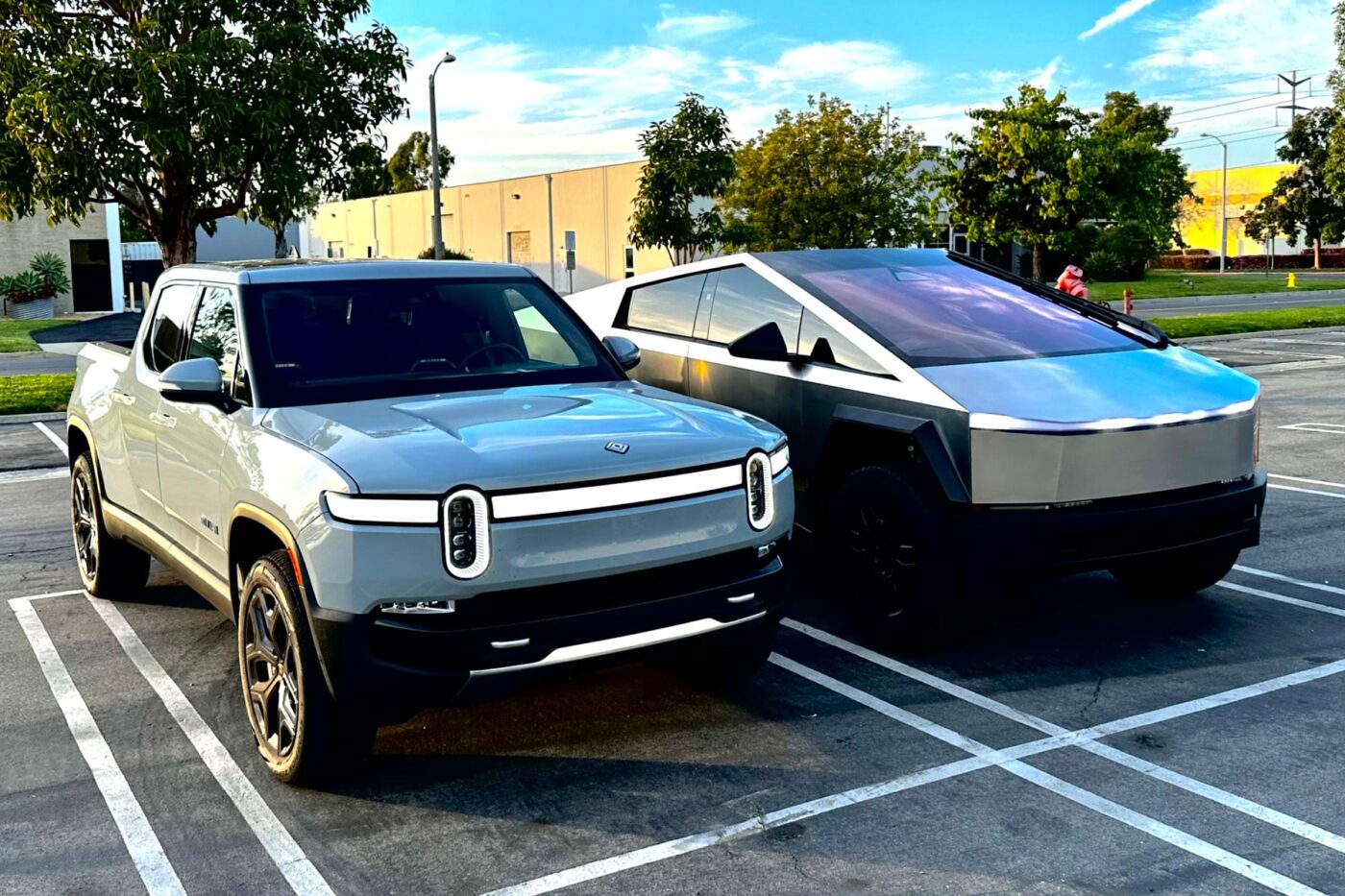
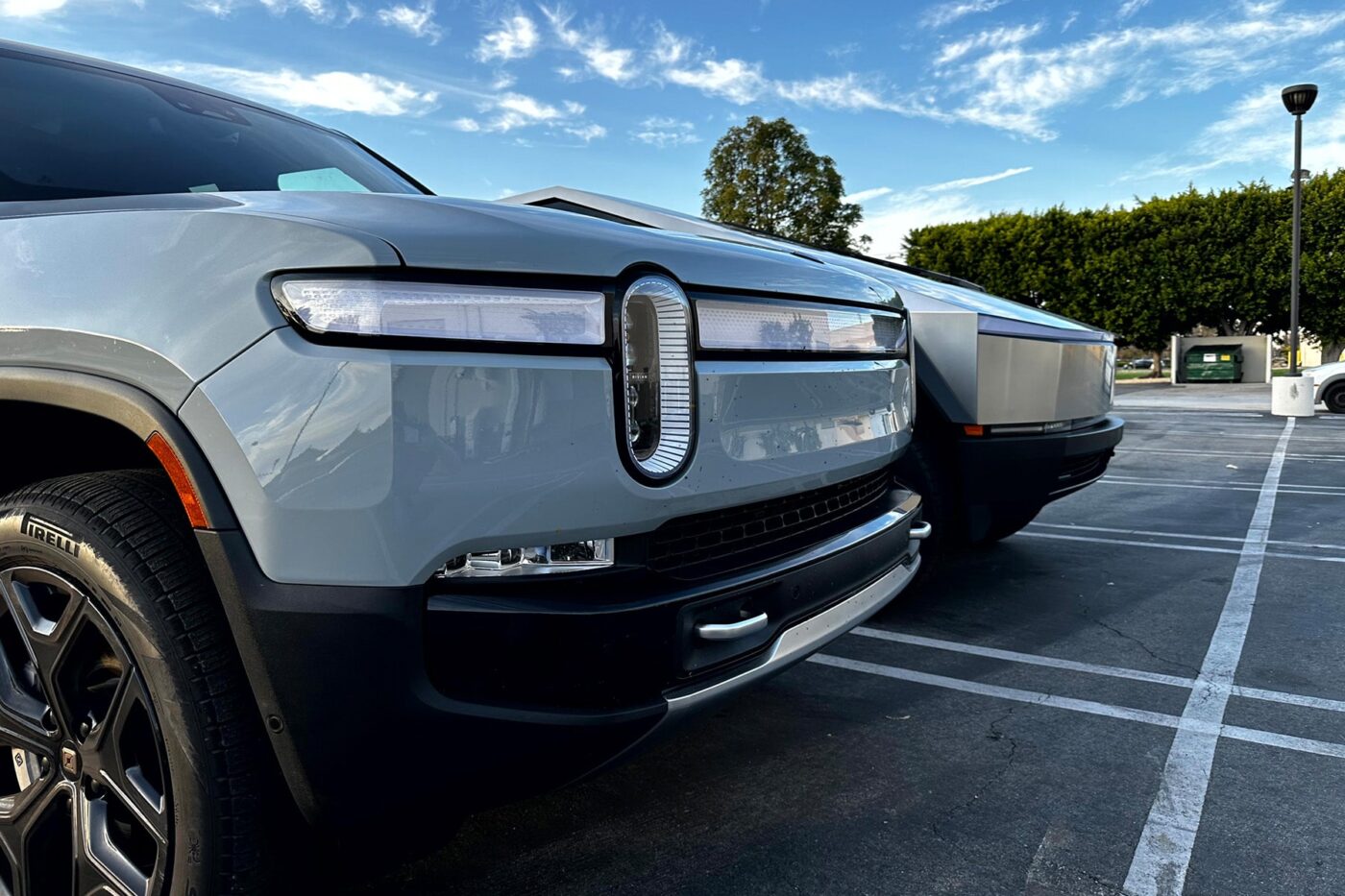
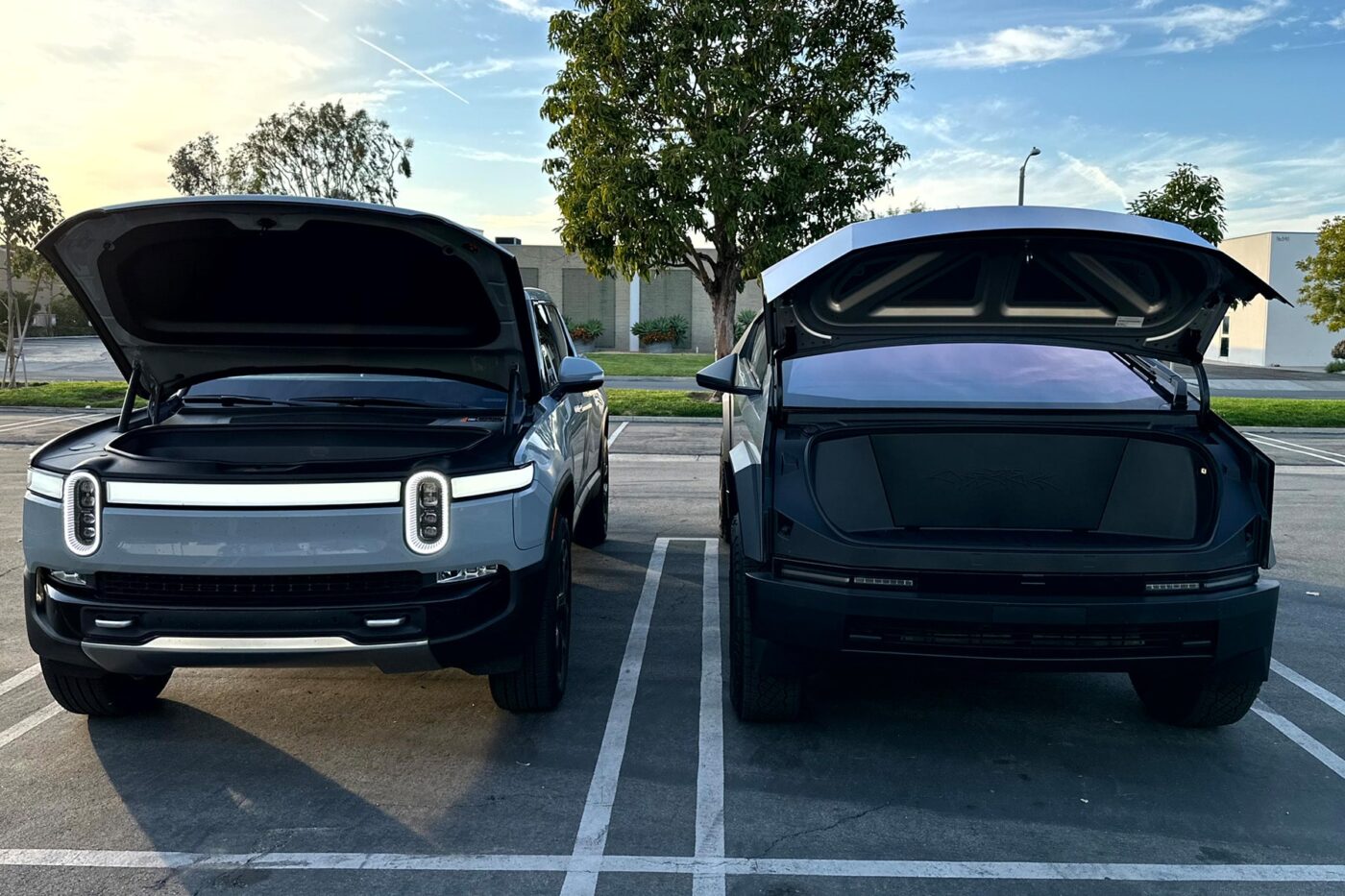
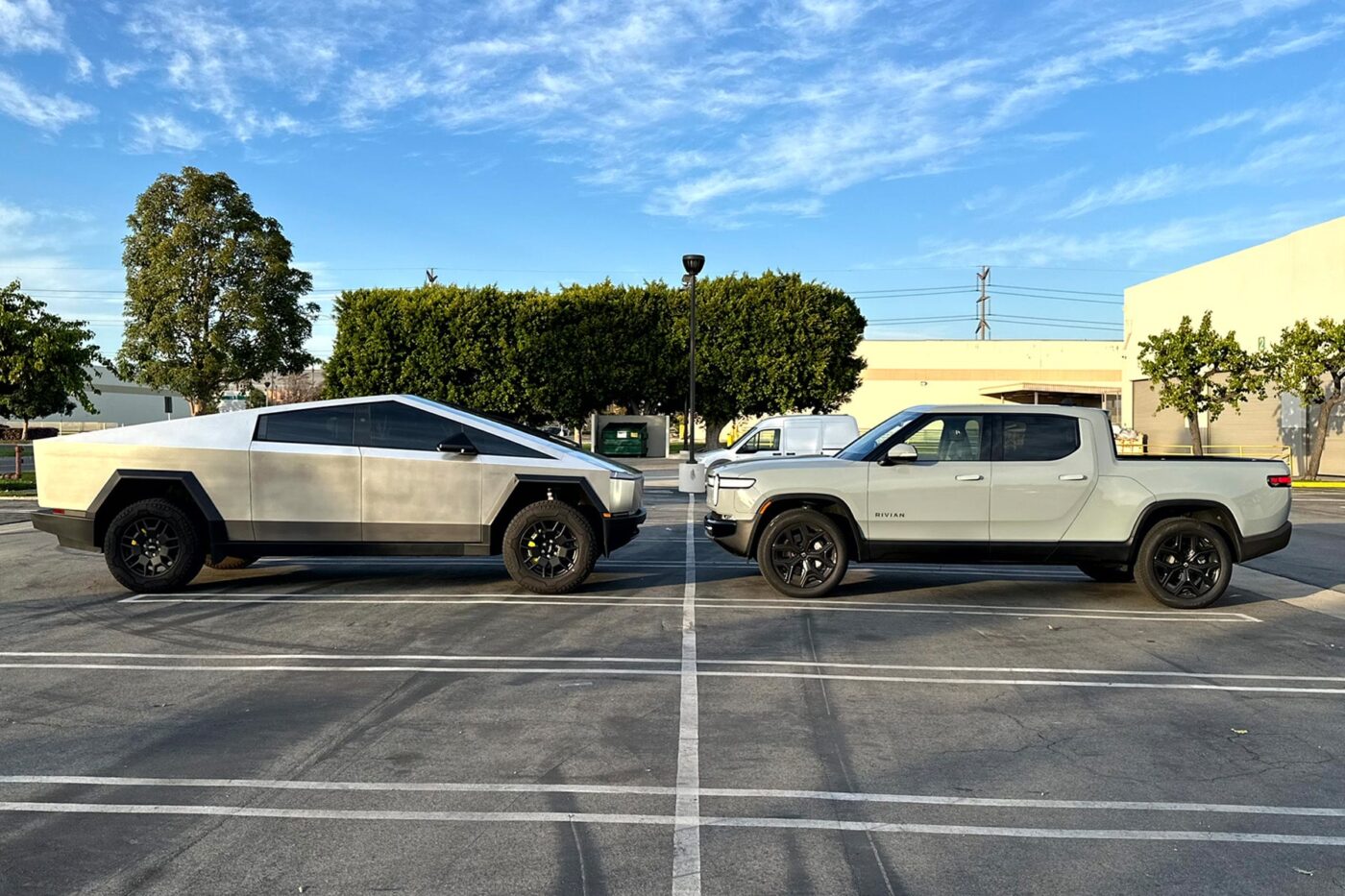
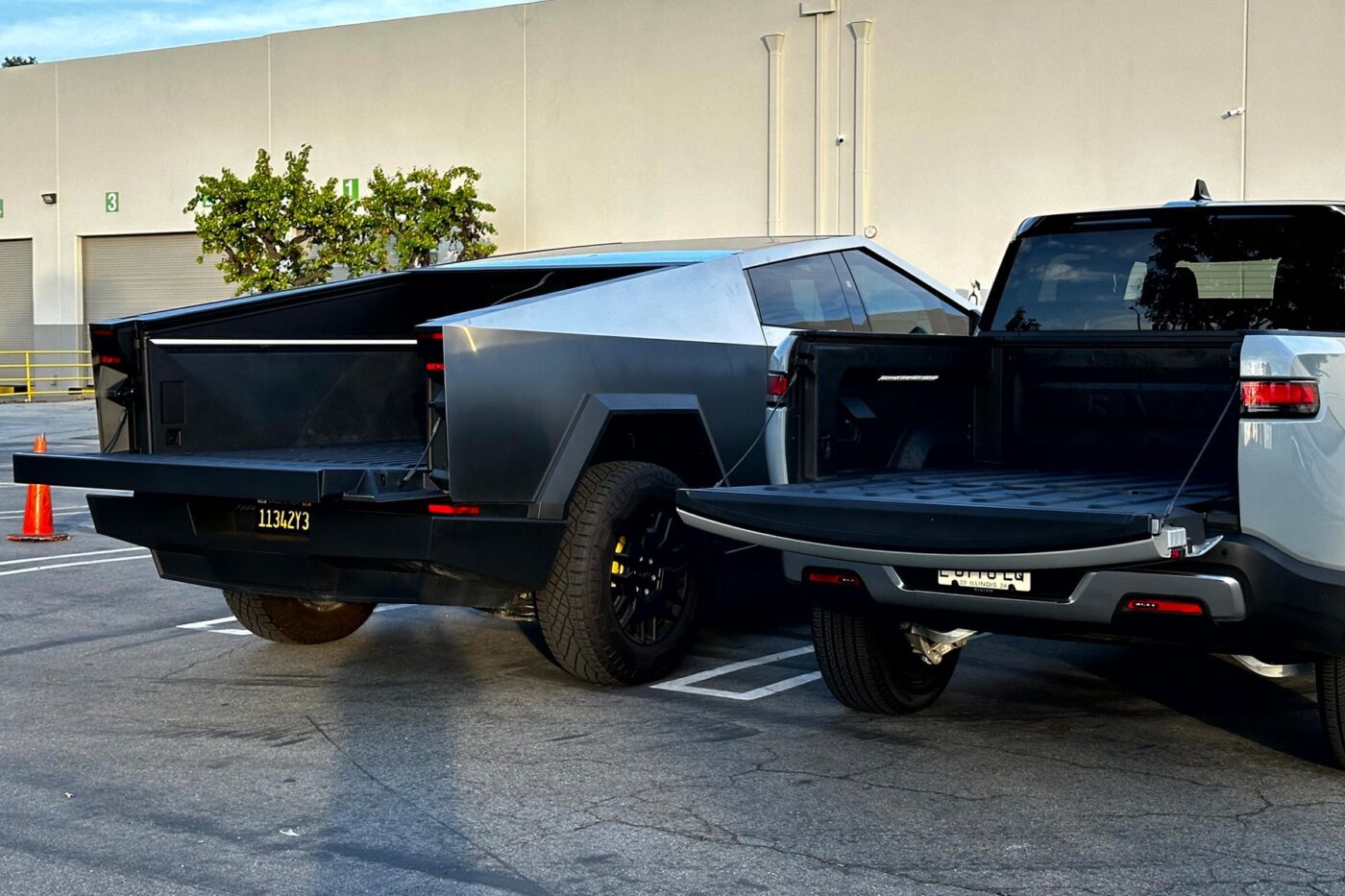
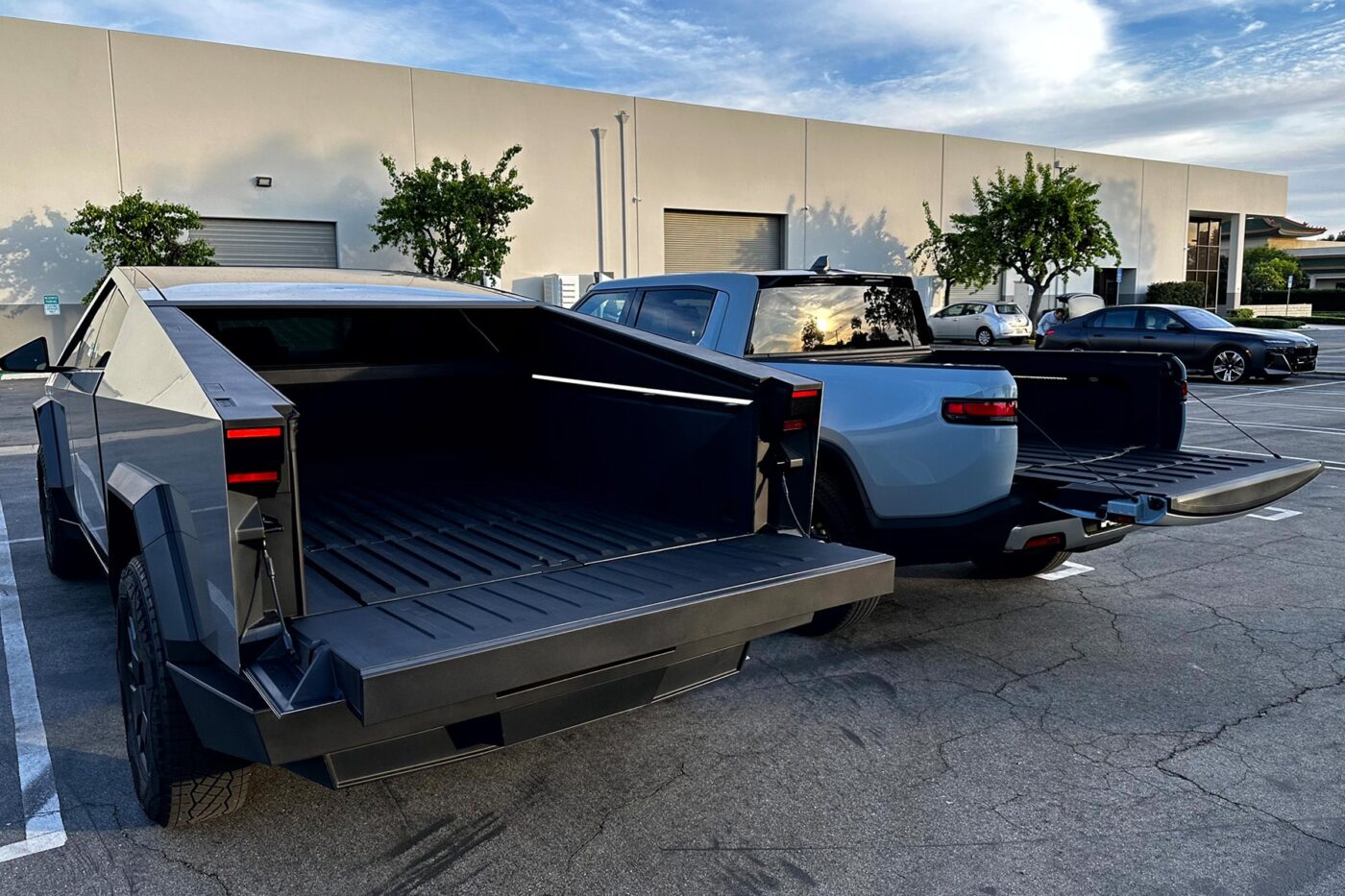
A quick word about the Cybertruck’s light: at this point, it is essential to clarify that the striking, continuous light strip at the front of the vehicle is only the daytime running light, which shines particularly brightly but is just for show. The main headlights with low and high beams and indicators are located around half a metre below, between the frunk and the black bumper, slightly to the rear and well hidden.
The Cybertruck is for real polishing enthusiasts
One of the most discussed things about the Cybertruck is the paint or lack thereof. Our Cybertruck came in bare stainless steel. As you know from the official pictures, it looks great at first glance, which also applies to the Cybertruck in black. But as cool as this may seem, the more you look at it, the more issues appear, and after two days of testing, every fingerprint we leave on the body is still visible. You can also see slight scratches and tarnished, stained metal in the surface structure. It remains to be seen what the whole thing will look like after a few months or years. Anyone who wants to protect the Cybertruck from corrosion and scratches has a job to do and owns a car for real polishing enthusiasts.
We also noticed negatively the transitions of the body parts at the gaps and on the frunk: the edges are all sharp and not rounded. If you run your finger along the slits, you can almost cut yourself. The angular front flap is also sharp-edged at right angles. From our point of view, this alone will make the Cybertruck unsuitable for use in Europe as active and passive pedestrian protection is virtually non-existent and a real danger for pedestrians, cyclists and other motorists. Even in the USA, there is no official crash test, only footage from Tesla’s own test.
Speaking of the front: behind the mighty front flap, which opens fully, there is a large frunk that is open at the front (like that of the Ford F-150 Lightning), which can mean that you have to be careful that nothing falls out. More importantly, however, the frunk closes with full force. Numerous videos online show testers holding a carrot between the frunk and the body. When closing, the front flap splits the carrot in two – what if an arm or a hand was between them? Unthinkable.
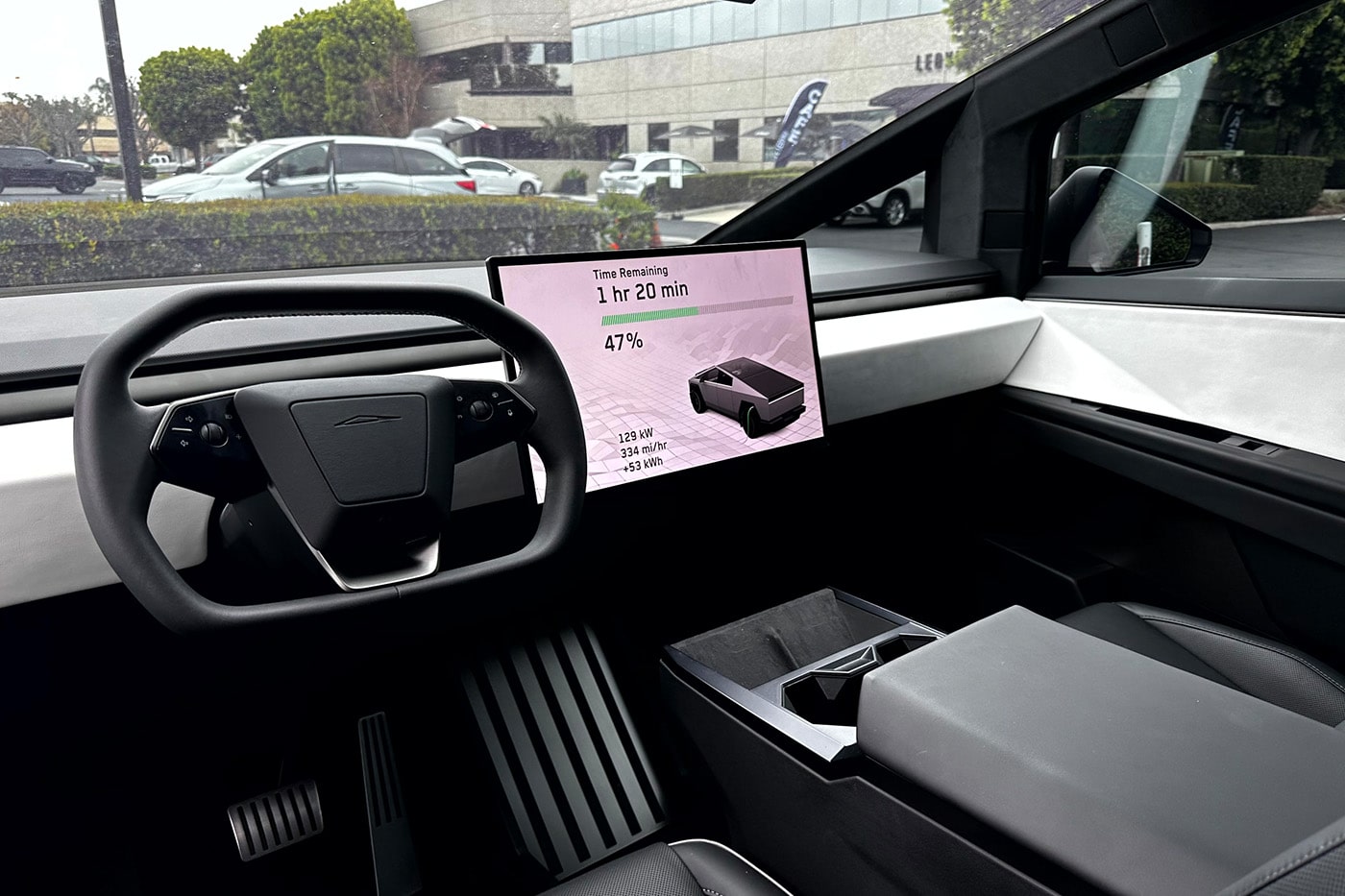
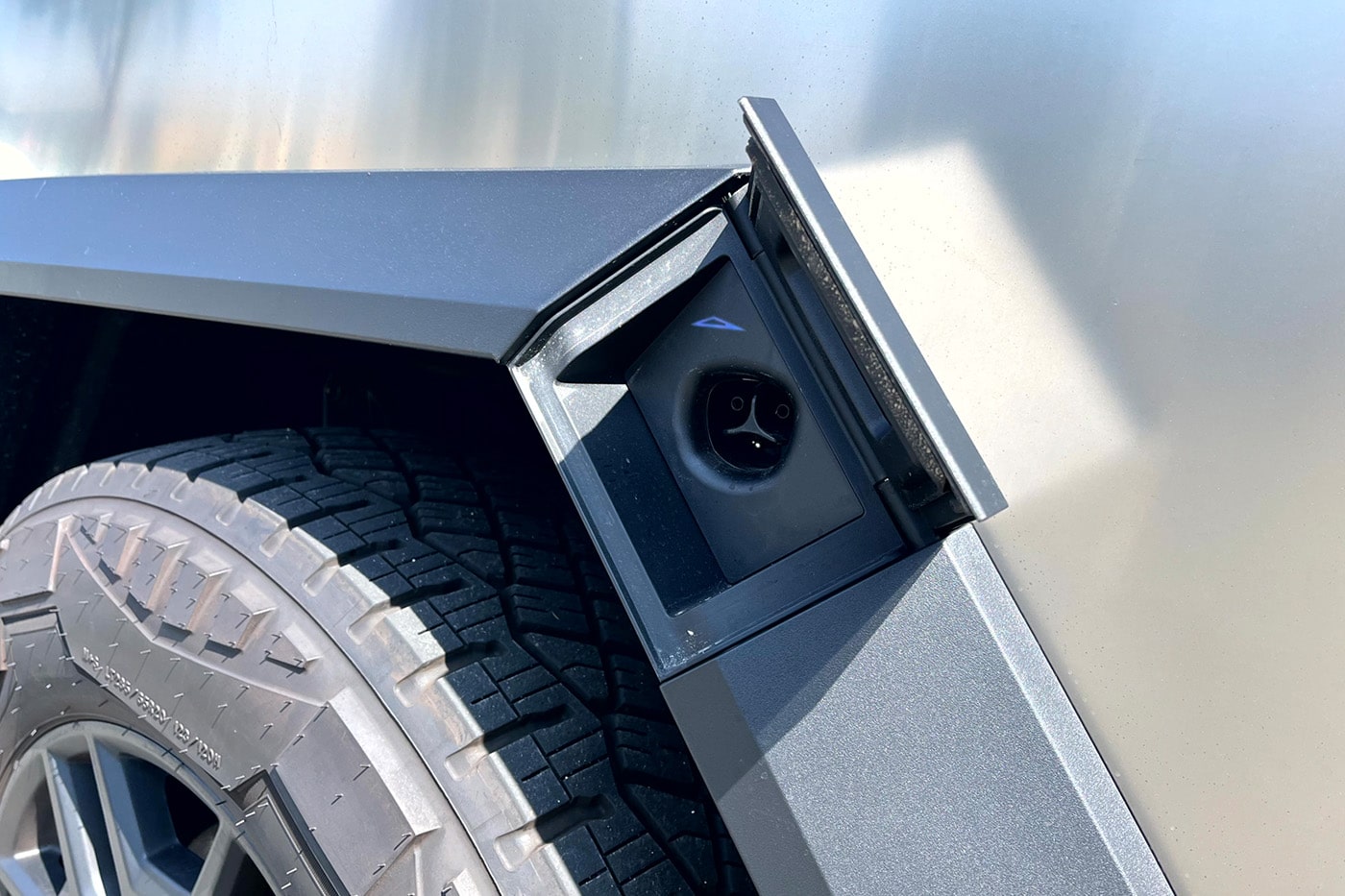
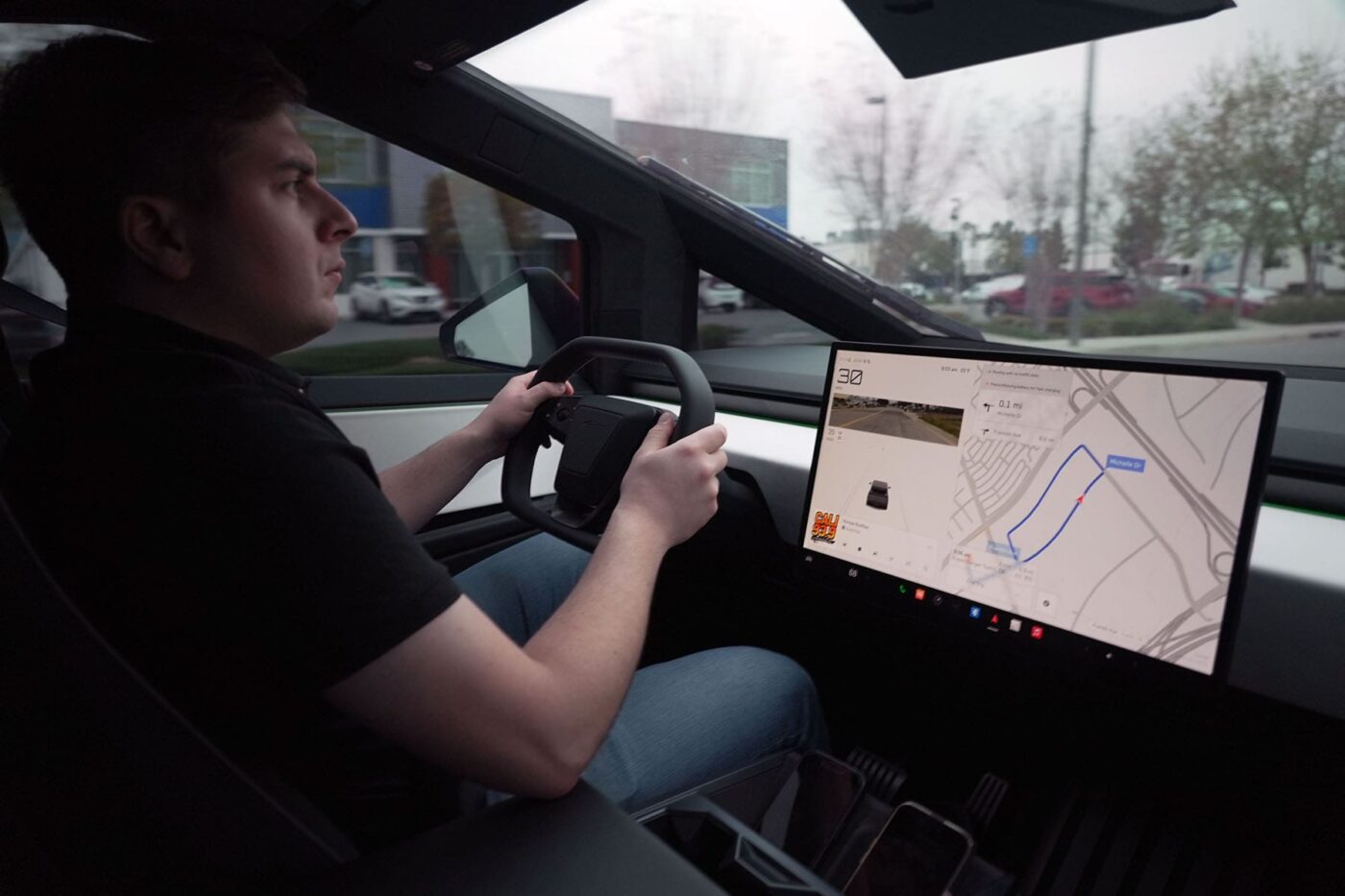
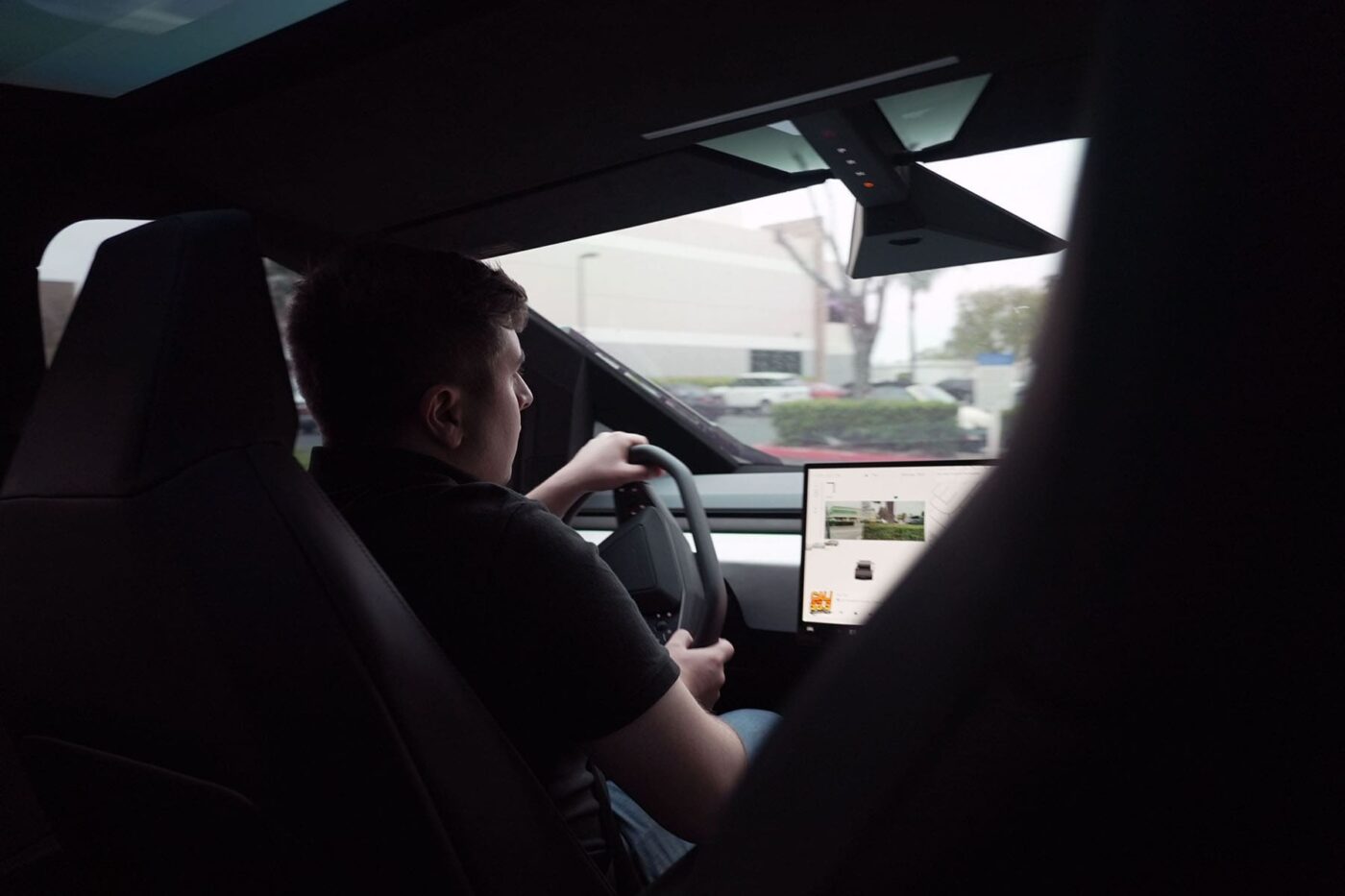
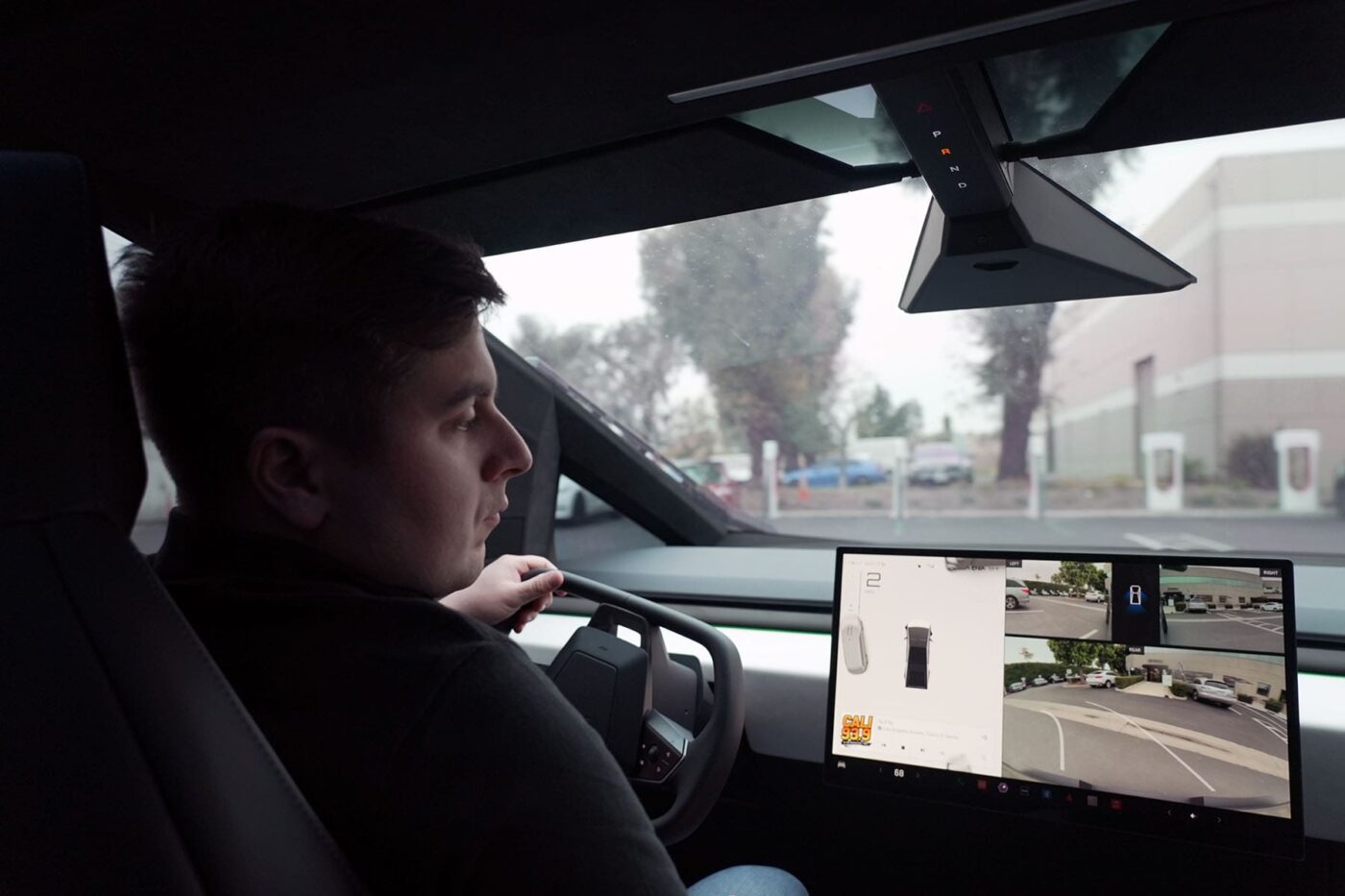
The fitted studded tyres lead to higher consumption in everyday use, and the rolling noise is also barely audible. This means that the only advantage is the “cool” look, as the tyres actually lead to a loss of comfort, which we also notice on the not-always-perfect roads and highways in the Californian metropolitan region.
Something else is noticeable, although probably less frequently in the sunny state of California – the single windscreen wiper is extremely loud when it changes direction. Whenever the pressure side of the rubber lip changes from left to right along the whole length of the wiper, a loud, deep crack can be heard, amplified by the large windscreen. Unpleasant.
The Cybertruck is marketed as a pickup. However, it lacks the essential characteristics of a pickup truck. The large cargo area could be more practical. The side raises higher towards the front and looks good, but it makes loading harder. There are many lashing eyes and power outlets on the truck bed, but the roller blind (tonneau) looks more like a design accessory, and you have to open it every time you want to use the loading area. When it is closed, the rear is dark, and the existing rear windows are entirely superfluous.
Conclusion
One thing is certain: the Cybertruck is a car that the world doesn’t need and is provocative. Yet, it inspires people. We were often approached, photographed and admired. It is a car that stands out and polarises even in LA’s dense traffic. We were impressed by the steering and the general driving behaviour. Consumption and range match the competition and, at 400 miles, are suitable for everyday use. We would have hoped for more charging, but perhaps that will change when the Cybertruck can be charged at an 800-volt or 1,000-volt charger.
What we will remember badly is the pickup’s lower quality feel and suitability for everyday use. We were also disappointed by the assistance systems and connectivity. In all likelihood, we will never be able to officially purchase and drive the Cybertruck in Europe, as crash issues, protection against other vehicles, and the weight (4.2 tonnes max. permitted total weight) will not allow it to be registered as a passenger car. Another thing is certain: with a width of 2.4 metres, the Cybertruck is almost as wide as a lorry and has proven too big for our European roads.
In conclusion, all we can say is that if you want to stand out in traffic, the Cybertruck is the right vehicle for you. Our test car had a price tag of around 100,000 dollars, quite a lot o
money, but many American buyers readily pay for a status symbol.
We returned the Cybertruck to the car park, where we picked it up. Then we got back into our BMW i7 xDrive60 and drove to the hotel, realising how quickly we had gotten used to Tesla’s steer-by-wire steering. On the way back, we swim along with the traffic in LA rush hour and almost disappear between all the cars on the five-lane motorway because we don’t stand out with the conspicuous BMW 7 Series. No photos, no thumbs up, no cars slowing us down – how pleasant.
Author: Marian Cammerer, P3 Group GmbH

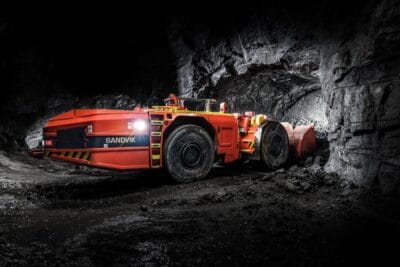
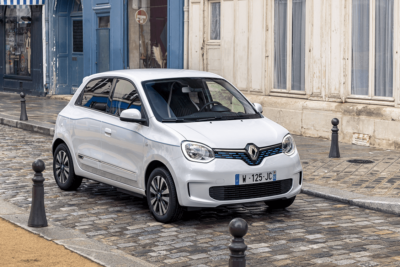
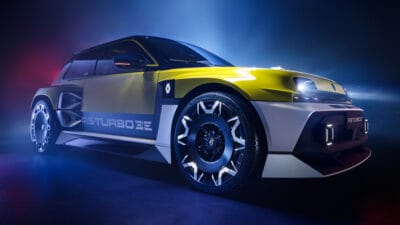
1 Comment